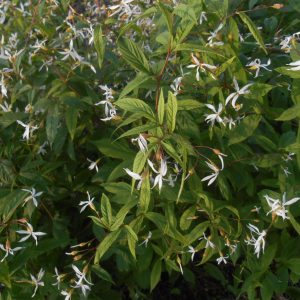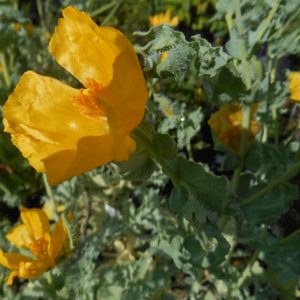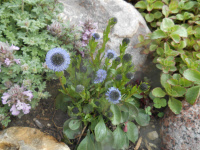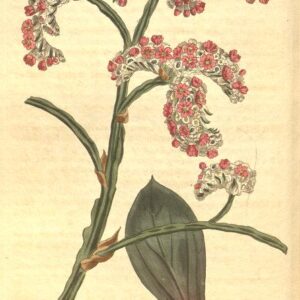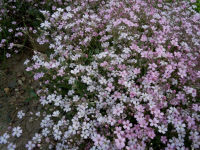Shop
Showing 337–344 of 788 results
-
Gift Certificate
-
Gillenia trifoliata Syn. Porteranthus trifoliata Indian physic Z 5-9
White stars flutter as butterflies atop wire-like red stems in June. In fall foliage turns red. One of internationally known garden designer Piet Oudolf’s 100 “MUST HAVE” plants, Gardens Illustrated 94 (2013)
White stars flutter as butterflies atop wire-like red stems in June. In fall foliage turns red. One of internationally known garden designer Piet Oudolf’s 100 “MUST HAVE” plants, Gardens Illustrated 94 (2013)
Size: 3’ x 2’
Care: part shade in moist well-drained soil
Native: from Canada to Georgia
Wildlife Value: Its nectar attracts many bee species and butterflies. Deer resistant.
Awards: England’s Royal Horticultural Society Award of Merit and Great Plant Pick Award from Elisabeth Carey Miller Botanical Garden.Cherokee chewed the root to alleviate bee stings and toothaches. Small sips of the tea relieved asthma and colds, (larger quantities lethal.) Native Americans took the dried, powdered root as a laxative. Gillenia named for German botanist Arnold Gille (1586-1633) published by another German botanist Conrad Moench. 1st collected by Rev. John Banister who moved to colonial Virginia in 1678. A gunman mistakenly shot and killed him while he collected plants. Offered for sale in Bartram Garden’s 1783 Broadside, America’s 1st plant catalog. Jefferson considered this medicinal in Notes on the State of Virginia. Grown at America’s 1st botanic garden, Elgin Botanic Garden 1811.
-
Glaucium flavum Yellow horned poppy Z 5-10 short-lived perennial, reseeding generously
Its silver, deep-cut foliage is reason enough to grow this. The bright yellow flower much of summer tops it off.
ARCHIVED
Note: This is a plant not currently for sale. This is an archive page preserved for informational use.
Its silver, deep-cut foliage is reason enough to grow this. The bright yellow flower much of summer tops it off.
Can not ship to: Maine and Massachusetts
Size: 1-2’ x 1-2’
Care: sun in well-drained soil
Native: Europe esp. sea coasts.
Wildlife Value: deer resistantThis was identified by Dioscordies in De Materica Medica for medicinal use around 70 A.D. Philip Miller’s Dictionary (1763) called it Cheliodonium glaucium while Tournefort (1703) called it Glaucium flore luteo. Thank goodness for common names – it is ID’ed as Yellow Horn Poppy.
-
Globularia cordifolia Globe daisy, Wedge leaved globularia Z 5-9
Dense, blue, globe-shaped umbels in spring
OUT OF STOCK
Dense, blue, globe-shaped umbels in spring, mat forming, leathery, spoon-shaped leaves.
Size: 5” x 12”
Care: sun in well-drained soil
Native: alpine pastures in Switzerland and Pyrenees
Awards: Royal Horticultural Society Award of Merit.Collected before 1753. “The most desirable (Globularia) for the rockwork is the neat G. cordifolia which is a little prostrate trailing shrub with bluish flowers.” William Robinson 1879.
-
Globularia nudicaulis Globe daisy Z 3-8
Cobalt blue puffs on naked stems rise above compact rosettes of glossy oval leaves, May-June
Cobalt blue puffs on naked stems rise above compact rosettes of glossy oval leaves blooming May-June
Size: 4-8” x 4”
Care: Sun to part shade in well-drained soil. Drought tolerant/rock garden plant.
Native: northern Spain to the Pyrenees MountainsIn gardens before 1753
-
Globularia trichosantha Blue Globe Daisy Z 5-9
Globe-shaped blue puffs bloom in late spring above a mat of evergreen foliage
ARCHIVED
Note: This is a plant not currently for sale. This is an archive page preserved for informational use.
Globe-shaped blue puffs bloom in late spring above a mat of evergreen foliage
Size: 6-8” x 8-12”
Care: sun to part shade in well-drained soil
Native: Balkan region of eastern Europe.
Wildlife Value: Attracts beesCollected before 1839.
-
Goniolimon speciosum syn. Statice speciosa, Limonium Dwarf Statice Z 3-9
Evergreen, flat, agave-like blue-green rosette of leaves. In mid-summer light pink, flat-topped flower clusters held on leafless stems 10-12” above foliage. Very different, fun and easy to grow.
Evergreen, flat, agave-like blue-green rosette of leaves. In mid-summer light pink, flat-topped flower clusters held on leafless stems 10-12” above foliage. Very different, fun and easy to grow.
Size: 10-12’ X 8”
Care: sun in well-drained soil
Native: Steppes of Eurasia: Russia, Siberia, Mongolia & western ChinaCollected by German naturalist Johann Georg Gmelin (1709-1755)1st described in 1753 then named and renamed several times. Pictured in Curtis’s Botanical Magazine 18. No. 656 1803.
-
Gypsophila repens ‘Rosea’ Creeping baby’s breath Z 4-7
Tough but dainty appearing pink flowers on short, thin stems smother gray-green leaves from June to October. Excellent groundcover, front of the border or rock garden plant.
Tough but dainty appearing pink flowers on short, thin stems smother gray-green leaves from June to October. Excellent groundcover, front of the border or rock garden plant.
Size: 8" x 10-12"
Care: Full sun in well-drained soil.
Native: Mountains of central and southern EuropeGypso is Greek meaning “gypsum or lime.” Phylos means “loving.” Plant requires limey (alkaline) soil. Discovered in Siberia in 1774.


